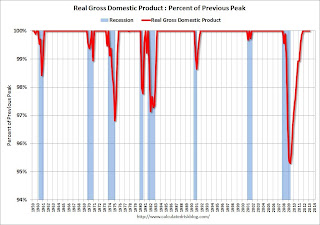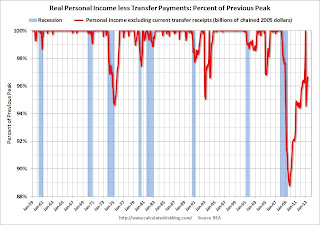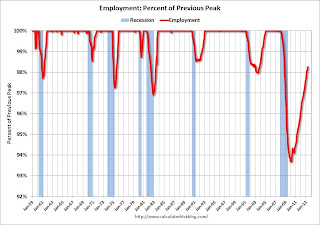by Calculated Risk on 7/01/2013 01:31:00 PM
Monday, July 01, 2013
Update: Recovery Measures
By request, here is an update to four key indicators used by the NBER for business cycle dating: GDP, Employment, Industrial production and real personal income less transfer payments.
Note: The following graphs are all constructed as a percent of the peak in each indicator. This shows when the indicator has bottomed - and when the indicator has returned to the level of the previous peak. If the indicator is at a new peak, the value is 100%.
These graphs show that most major indicators are still below the pre-recession peaks.
 Click on graph for larger image.
Click on graph for larger image.
This graph is for real GDP through Q1 2013.
Real GDP returned to the pre-recession peak in Q4 2011, and has hit new post-recession highs for six consecutive quarters.
At the worst point - in Q2 2009 - real GDP was off 4.7% from the 2007 peak.
 This graph shows real personal income less transfer payments as a percent of the previous peak through the May report.
This graph shows real personal income less transfer payments as a percent of the previous peak through the May report.
This measure was off 11.2% at the trough in October 2009.
Real personal income less transfer payments returned to the pre-recession peak in December, but that was due to a one time surge in income as some high income earners accelerated earnings to avoid higher taxes in 2013. Real personal income less transfer payments declined sharply in January (as expected), and were still 3.3% below the previous peak in May.
Real personal income less transfer payments will probably be the last major indicator to return to pre-recession levels (excluding the spike last December).
 The third graph is for industrial production through May 2013 - although production growth has slowed recently.
The third graph is for industrial production through May 2013 - although production growth has slowed recently.
Industrial production was off over 17% at the trough in June 2009, and has been one of the stronger performing sectors during the recovery.
However industrial production is still 2.1% below the pre-recession peak. This indicator might return to the pre-recession peak in late 2013 or in 2014.
 The final graph is for employment and is through May 2013. This is similar to the graph I post every month comparing percent payroll jobs lost in several recessions.
The final graph is for employment and is through May 2013. This is similar to the graph I post every month comparing percent payroll jobs lost in several recessions.
Payroll employment is still 1.8% below the pre-recession peak and will probably be back to pre-recession levels in 2014.
All of these indicators collapsed in 2008 and early 2009, and only real GDP is back to the pre-recession peak (personal income returned to the previous peak in December due to a one time increase in income).


